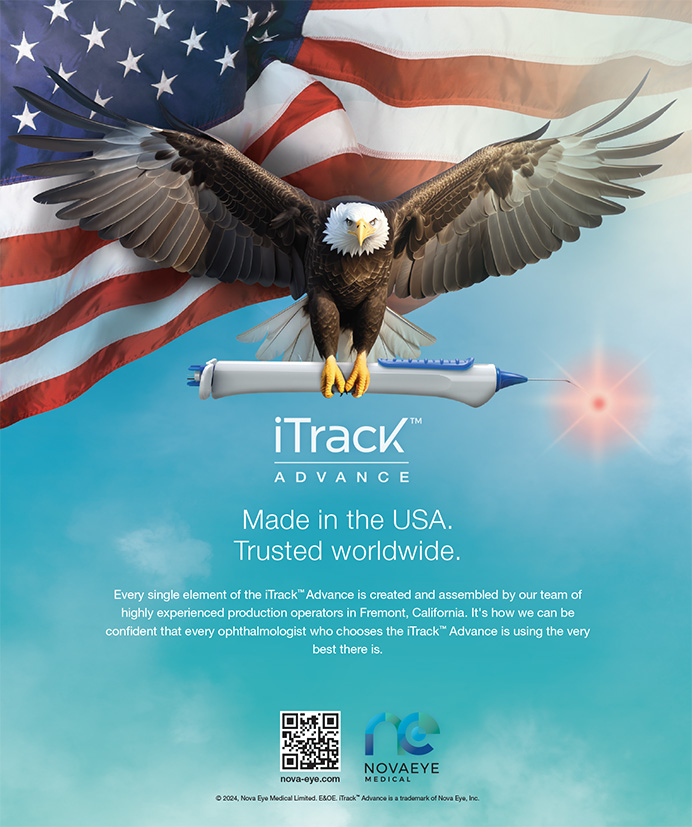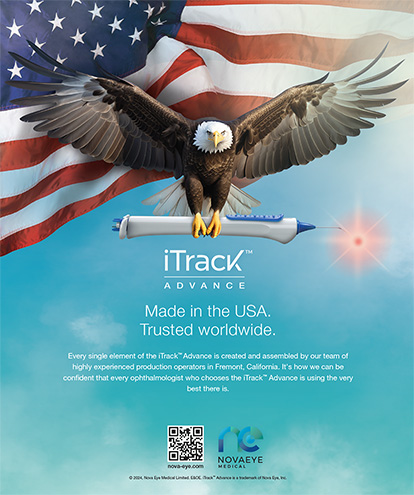During the past 4 years, we have seen Custom LASIK, Epi-LASIK, Intralase LASIK (Intralase Corp., Irvine, CA), and all the presbyopia-correcting IOLs integrated into our full-service refractive surgery practice. The Visian Implantable Collamer Lens (ICL; STAAR Surgical Company, Monrovia, CA) is the latest of the series of refractive surgical advancements offered to our patients. Thus far, the patients at Loden Vision Centers have reported 100 satisfaction with the Visian ICL, and all say that they would have the procedure performed again.
POSTOPERATIVE OBJECTIVE
The results with the Visian ICL in our practice explain patients' enthusiasm and acceptance of the procedure. Of Dr. Loden's first 26 consecutive eyes, none has lost a single line of BCVA. Moreover, 38 (10 of 26 eyes) achieved an improvement in BCVA of one line or more. Ninety-two percent (24 of 26 eyes) achieved UCVA that is greater than or equal to their preoperative BCVA without any LASIK enhancements. No lens exchanges were needed. The only complication we encountered was a case of pupillary block glaucoma that occurred secondary to our inadequately sized peripheral iridotomies. Throughout these first cases, we identified several tips for success with the implantation of the Visian ICL.
TIPS FOR SUCCESS WITH THE ICL
Respect the Laser Peripheral Iridotomy
The adequate sizing of the laser peripheral iridotomy is crucial to avoiding pupillary block. The iridotomy must be large enough to allow both Occucoat viscoelastic (Bausch & Lomb, Rochester, NY) and aqueous to pass through the opening. STAAR Surgical advises using only Occucoat with the Visian ICL, because other viscoelastics have been implicated as a potential cause of cataract formation.
Do Not Use Too Much Viscoelastic
It is important for the surgeon to place only enough Occucoat to stabilize the anterior chamber prior to the Visian ICL's insertion. If the surgeon cannot see the ?chains? of viscoelastic, then the anterior chamber has been overfilled with viscoelastic, and the Visian ICL may float up next to the cornea after injection. The lens' floatation makes tucking its haptics much more challenging and greatly increases the chance of endothelial trauma due to inadvertent contact between the lens' positioner and the endothelium. The difficulty of positioning the haptics may also increase the risk of cataract formation.
Inject Viscoelastic Anterior to the Lens
After the ICL's insertion, placing a small amount of viscoelastic anterior to the ICL may facilitate the positioning of its haptics. The placement of viscoelastic can be accomplished via the main incision or through the paracentesis port incisions. Care must be taken not to inject viscoelastic on the same plane as the Visian ICL, because the material will have a tendency to track posteriorly and buoy the lens anteriorly.
Enlarge the Incision to 3.5mm
Typically, the surgeon uses a 3-mm keratome for the incision. Upon any difficulty in positioning the injector, the surgeon should not hesitate to enlarge the incision to 3.5mm. By expanding the incision with a shortcut blade, the surgeon ensures ample room for the injection cartridge's tip and may concentrate on the ICL's injection process.
Create Paracentesis Ports With an MVR Blade
Dr. Loden uses an MVR blade to create the paracentesis ports for ICL surgery as well as cataract surgery. The MVR blade is sized perfectly for the bimanual I/A tips to allow for a snug but easy entry every time. It is not necessary to advance the tip of the MVR blade far into the anterior chamber, so the possibility of iatrogenic anterior capsular trauma decreases.
Refract the Patient Carefully
The selection of the ICL's power is based on the manifest and cycloplegic refractions. If there is an error in the refraction or the vertex distance is not measured, the patient's ICL power will be off as well. Surgeons need to perform precise refractions and vertex measurements themselves without relying on technicians or automatic instruments.
Ensure Appropriate Vaulting
The eyes are usually very quiet postoperatively. The conjunctiva is white, and the anterior chamber shows very little, if any, inflammation at the slit lamp. The most important determination during the slit-lamp examination is the estimation of the vaulting of the ICL. Excessive arching (ie, anteriorly) may cause the implant to touch the iris and lead to pigmentary dispersion syndrome with the possibility of pigmentary glaucoma. If the lens is too flat or even flexes posteriorly, the ICL may touch the crystalline lens and create a cataract. To view the vaulting, angle the slit beam at 30° to 45° and observe the separation between the anterior surface of the crystalline lens and the posterior surface of the ICL. The visible separation should be approximately one to one-and-a-half times the corneal thickness. If the ICL is noted to have a high or low vault across the crystalline lens, observation rather than IOL exchange is the best option. Our personal experience has shown no ICL to have low vaults with lens touch. Several ICLs were noted to have high vaults with excellent uncorrected vision and no sign of pigmentary dispersion.
CONCLUSION
Overall, the Visian ICL has been successful in our practice, and we are offering the lens to all refractive surgery candidates with more than 4.00D of myopia. Patients seem to understand the Visian ICL's risks but feel that the potential reversibility of the procedure outweighs the dangers. There seems to be a subset of myopic patients that has avoided LASIK secondary to the implantation of the Visian ICL because the earlier involves the permanent removal of corneal tissue. This subset finds comfort in the facts that the ICL can be removed and that, in a worst-case scenario, the capability for still obtaining 20/20 vision with cataract surgery exists. From the surgeon's perspective, it is comforting to know that there has not been a single case of endophthalmitis reported with the ICL in North America. If the aforementioned tips are combined with meticulous surgical technique in avoiding contact with the crystalline lens, the ICL's implantation will prove to be a safe, enjoyable refractive procedure.
James C. Loden, MD, is President of Loden Vision Centers in Nashville, Tennessee. He acknowledged no financial interest in the products or companies mentioned herein. Dr. Loden may be reached at (615) 859-3937; lodenmd@lodenvision.com
Daniel J. Schimmel, OD, is Optometric Director at Loden Vision Centers in Nashville, Tennessee. He acknowledged no financial interest in the products or companies mentioned herein. Dr. Schimmel may be reached at (615) 859-3937; dnlschimmel@yahoo.com.


